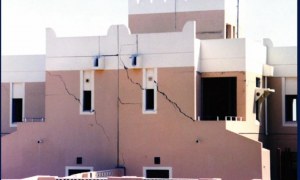🕑 Reading time: 1 minute
Trail pits are the first option considered for soil investigations regardless of type of soil investigation. So, it is considerably crucial to establish suitable layout for trial pits to achieve the goal of the test properly. In this article, recommendations and considerations that need to be taken into account while the layout of trial pits are set up along with the trial pit purposes will be discussed.
Fig.1: Layout of Trial Pits for Site Investigation
Following topics regarding trial pits for site investigation are discussed:- What are the trial pit purposes?
- Trial pit layout
- How to specify the required number of trial pits?
- How to determine trial pit depth?
Contents:
What are the Purpose of Trial Pits in Site Investigation?
Different information about soil condition of project site can be produced using trial pits during site investigation. They are:- Soil classification
- To what extent does the side wall of excavation is stable
- Specify the location of water table
- Determine the influence of groundwater seepage on structure; specify whether groundwater seepage impose side effects on the structure or not.
- Determine whether the project site can be trimmed, rammed and leveled easily or not.
- Determine whether fill material is present at the site or not and specify its depth it exists.
- Trial pits are also used around borehole for soil correlation purposes.
- High quality undisturbed samples can be taken from trial pits for tests to determine soil strength.
- Data achieved though trial pits can be combined with other soil data for the design purposes if project site condition is difficult and samples can only be achieved with great difficulty and effort.
- Trial pits can be used to determine the location of underground utilities and hand digging should be used in this case.
- Finally, trial pits would explain whether foundation excavation can be conducted easily or need considerable effort.
How to Set Up Proper Layout of Trial Pits for Site Investigation?
The location of trial pits should be neither so close or far away from foundation of the structure. This is because the soil condition cannot be evaluated properly in the latter case and trail pits could create detrimental influence on the foundation excavation and underground utilities. Trial pits should be distributed properly to be able to obtain cross sections along the major axis of project site. Several trial pits are commonly dug around boreholes if used at project site to help with soil correlation.How to Specify the Required Number of Trial Pits?
It is recommended to dig at least five trial pits along a major axis.How to Determine Trial Pit Depth?
Commonly, trial pits are suitable for shallow depth soil exploration and maximum economical depth for trial pits is 4m and it should not be less than 1.5m. The depth of trial pits should be at least equal to the depth of foundation excavation. So, it is not allowed to dig a trial pits with a depth smaller than excavation depth.
Fig.2: Trial pit illustrate smallest plan size need for investigators and economical depth
If the side wall of trial pits is expected to fall, then it is necessary to provide adequate support for side walls or create stepped trial pits to create working environment for the investigators. If the project is not protected and fenced properly and open, then it would be necessary to provide adequate protection for the trial pits when they are left at the end of each working day. Trial pits might be kept open for a specific period to conduct water seepage observation and the likelihood of trial pit deteriorations over that period of time. Read More: How to Setup Borehole Layout for Site Investigation of Different Foundations? Role of Design Engineer in Geotechnical Investigations Soil Investigation and Foundation Types Environmental Considerations in Site Investigation

